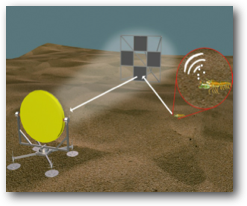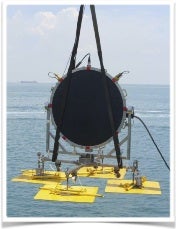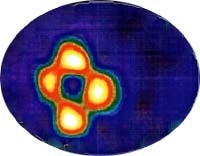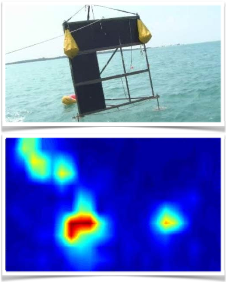The principle underlying ANI makes use of the ensonification provided by the ambient noise field to create pictorial images of underwater objects. ANI is well suited for the warm shallow waters of south east Asia, where snapping shrimp serve as an excellent source of acoustic illumination. Snapping shrimp are also found in many other warm shallow water areas around the world.
We have developed a class of new algorithms including the one based on the acoustic daylight idea to form images out of the ambient noise data. We have also built a system called Remotely Operated Mobile Ambient Noise Imaging System (ROMANIS), an ambient noise imaging underwater acoustic camera.

ROMANIS

- Broadband system covering 25-85 kHz.
- Hierarchical and modular design.
- Synchronous sampling and the data streamed at the rate of 1.6 Gbps.
- A novel dry-coupled neoprene acoustic window to avoid oil-filled or potted sensors.
- Gas filled with 0.5 bar of Helium for better thermal management.
- Near-realtime beamforming by parallel computing using GPU technology.
Statistical Imaging Techniques
Initial work with data from a previous ANI camera (ADONIS) led to the development of acoustic daylight and higher-order statistical imaging. The key idea is to find image areas showing a contrast with the background in terms of the statistics, and to associate these areas with targets that may be reflecting ambient noise from a different direction and hence having different statistics. Tools such as Kalman filters were used to track targets through times when the acoustic “illumination” was not suitable for imaging.
The noise made by snapping shrimp is compact in time, broadband, and highly impulsive. With a large number of these snaps arriving at a receiver, the generalized central limit theorem allows us to model the resulting pressure variation accurately using symmetric alpha-stable distributions. More recently, signal processing based on these distributions leads to ANI algorithms that utilize fractional low-order moments (FLOM) and fractiles. These algorithms yield more stable and consistent results, as compared with previously developed methods that employ energy estimates and high-order statistics.


Passive range estimation and 3D imaging
Most ANI techniques today are based on statistical properties of the ambient noise. An alternative approach is to localize loud “snaps” in space and time, and then to utilizing the knowledge of the source to deterministically process the echoes. While this idea is attractive and offers the possibility of passive ranging and 3-dimensional imaging, it is difficult to implement in practice. The key difficulty lies in associating a snap with its echoes, as all snaps sound similar and arrive at the receiver overlapping in time with the echoes from other snaps. A voting algorithm proposed recently solves the association problem in a quasi-static scenario using some physical constraints and an ensemble of arrivals. Using this algorithm, ROMANIS was shown to be able to estimate range to a target passively. This demonstration opens a whole new exciting area of research, where existing techniques developed for multi-static sonar may be applied to ANI.


